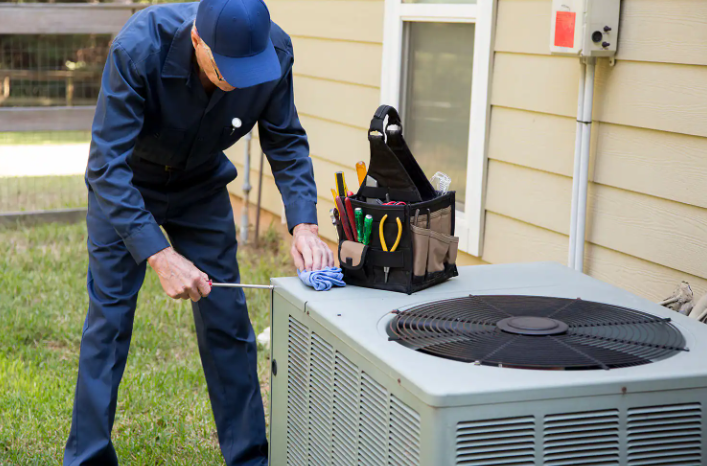Imagine a chilly winter morning. Frost clings to the windows and your breath forms tiny clouds in the air. Now picture stepping into a cozy room where warmth envelops you like a gentle hug. That magical transformation is courtesy of an unsung hero—the HVAC system.
What Is HVAC?
HVAC stands for heating ventilation and air conditioning. It’s the wizardry behind maintaining the perfect indoor climate. Whether it’s sweltering heat or bone-chilling cold HVAC systems work tirelessly to keep us comfortable. But they’re more than just temperature control—they’re the guardians of air quality too.
The Symphony of Components
Air Ducts: Imagine these as the secret tunnels in your home. Air ducts snake through walls and ceilings carrying conditioned air from the central HVAC unit to every nook and cranny. Properly sealed and insulated ducts ensure energy efficiency.
Air Handlers: These indoor heroes circulate the treated air. Think of them as the conductors of this symphony. They contain blower motors fans and even evaporator coils (for cooling). Air handlers also bring fresh air into the system.
Central Units vs. Ductless Mini-Splits: Central systems treat air in a central unit and distribute it through ducts. Ductless mini-splits on the other hand exchange air directly with the living space. No ducts no fuss!
Clean Air Happy You
HVAC systems aren’t just about temperature—they’re air quality warriors. As air flows through filters catch allergens dust and other particles. Breathe easy, my friend!
Choose the Right HVAC System for your home
Choosing the right HVAC system for your home is crucial for comfort energy efficiency and cost savings. Let’s break it down:
Assess Your Needs:
- Consider your climate: Do you face extreme winters or scorching summers?
- Calculate the square footage of your home: Larger spaces need more powerful systems.
- Think about your family’s preferences: Some people love warmth while others prefer cooler temperatures.
Types of HVAC Systems:
- Split Systems: These have indoor and outdoor components. Commonly used for central heating and cooling.
- Ductless Mini-Splits: Ideal for homes without ductwork. They allow zoned temperature control.
- Packaged Systems: All components (heating cooling and air handling) are in one unit. Suitable for smaller spaces.
Energy Efficiency Matters:
- Look for systems with high SEER (Seasonal Energy Efficiency Ratio) ratings for cooling and AFUE (Annual Fuel Utilization Efficiency) ratings for heating.
- Consider ENERGY STAR® certified models—they save energy and reduce utility bills.
Zoning and Thermostats:
- Zoning allows different areas of your home to have individual temperature settings.
- Smart thermostats learn your habits and adjust accordingly.
Professional Installation:
- Hire a licensed HVAC contractor. Proper installation ensures optimal performance.
- Ask for recommendations and check reviews.
Maintenance and Warranty:
- Regular maintenance keeps your system running smoothly.
- Check the warranty—longer coverage means peace of mind.
your HVAC system is an investment. Choose wisely and you’ll enjoy comfort year-round!
Common HVAC Problems and how to Troubleshoot them
HVAC systems are essential for maintaining a comfortable indoor environment but they can encounter various problems that hinder efficiency. Let’s explore some common HVAC issues and how to troubleshoot them:
Uneven Cooling or Heating:
Issue: Uneven temperature distribution throughout the indoor space.
Troubleshooting:
- Check air vents and registers to ensure they’re open and unobstructed.
- Inspect ductwork for leaks or gaps.
- Calibrate your thermostat accurately.
Inadequate Airflow:
Issue: Weak or insufficient airflow.
Troubleshooting:
- Regularly check and replace dirty air filters.
- Inspect the outdoor condenser unit and indoor coils for debris.
- Verify that the blower motor is functioning correctly.
Short Cycling:
Issue: Rapid on-off cycles stress the system.
Troubleshooting:
- Ensure the thermostat is away from heat sources or drafts.
- Clean condenser coils and other components.
- Verify refrigerant levels.
Strange Noises:
- Issue: Unusual sounds (rattling banging hissing).
- Troubleshooting:
- Inspect fan blades for loose or damaged parts.
for complex issues or situations beyond DIY troubleshooting seek professional help. Your home’s comfort depends on a well-functioning HVAC system!
What are the signs that my HVAC system needs maintenance?
Your HVAC system is like the unsung hero of your home tirelessly working to keep you comfortable. Here are 10 common signs that it might be time for some maintenance:
Insufficient Airflow: Weak airflow from vents can indicate clogged filters blocked vents or blower motor issues. Uneven cooling or heating may result.
Uneven Cooling or Heating: If different areas of your home have varying temperatures it’s time to investigate. Leaks in ductwork or an improperly sized system could be the culprits.
Unusual Noises: Banging rattling or grinding sounds from your HVAC system need attention. Loose components or debris might be causing the commotion.
Foul Odors: Musty or unpleasant smells when your system runs could be due to mold stagnant water or debris buildup. Not only unpleasant but it can also affect indoor air quality.
Malfunctioning Thermostat: If your thermostat isn’t behaving it’s time to call in the experts.
Sudden Spike in Energy Bills: Unexpectedly high bills might signal inefficiencies or issues with your HVAC system.
Freon Water Leaks or Ice Buildup: These are red flags that require professional inspection.
High Humidity: If your home feels too humid your HVAC system might need attention.
Conclusion: The Comfort Chronicles
In our modern lives HVAC systems are unsung heroes. They weave comfort into our days ensuring we’re snug in winter and cool in summer. So next time you adjust that thermostat remember the magic happening behind the scenes.






